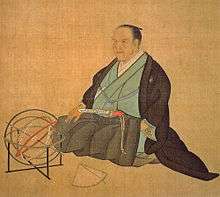Ōshio Heihachirō

_oshio.jpg)
Ōshio Heihachirō (大塩 平八郎, March 4, 1793 – May 1, 1837) was a former yoriki (a low-ranking samurai police inspector for the magistrates) and a Neo-Confucianism scholar of the Ōyōmei (Wang Yangming) school in Osaka. He is best remembered for his fierce opposition to the Tokugawa shogunate.
Career
Ōshio served as a yoriki for much of his life, until he found the newly appointed head of Osaka bugyō (one of the shogun's officials; the city magistrate) so hopelessly corrupt, that he decided to resign in 1830. By that time he had opened a school of his own, the Senshindō (洗心洞), and following his retirement he directed much of his efforts to teaching his followers. He later published a book known as Senshindō Sakki (洗心洞箚記), a compilation of his reading notes that were also used for his lectures. At the height of nineteenth century Japan's greatest famine, in 1836 he petitioned the magistrates to help the starving citizens. After this was refused, Ōshio sold all the books he possessed to buy food for the suffering. Adhering to one of Wang Yangming's central tenets that in times of crisis men must follow their intuition rather than their institution, Ōshio circulated a manifesto charging the bugyō with moral corruption. He then led an army consisting of his students, peasants, and some outcasts into the city in 1837. They managed to burn about a fifth of the city before government troops put down the rebellion. Months later, Ōshio committed suicide when he was found by the authorities. The novelist Mori Ōgai, active after the Meiji Restoration, wrote an eponymous novella on Ōshio Heihachirō, which was published in January 1914.
References
| Wikimedia Commons has media related to Ōshio Heihachirō. |
- Ebrey, Patricia Buckley; Walthall, Anne; Palais, James B. (2006). East Asia: A Cultural, Social, and Political History. Houghton Mifflin Company. p. 400. ISBN 0-618-13384-4.
- Tipton, Elise (2002). Modern Japan: A Social and Political History. Routledge. p. 19. ISBN 0-415-18538-6.
- Qingsong Shen; Vincent Shen; Willard Gurdon Oxtoby (2004). Wisdom in China and the West Cultural Heritage and Contemporary Change : CHINESE PHILOSOPHICAL STUDIES 第 22 巻. CRVP. p. 98. ISBN 978-1-56518-205-9.
